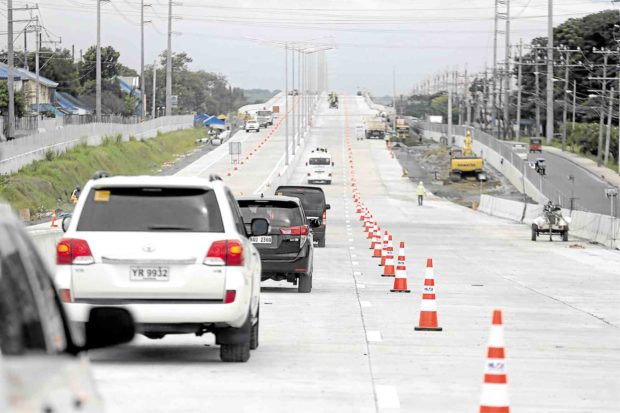
The Cavite-Laguna Expressway is among the 34 additional PPP projects started during the Duterte administration. (File photo by RICHARD A. REYES / Philippine Daily Inquirer)
Thirty-four projects that the government will pursue in partnership with the private sector have been added to 13 public-private partnerships (PPP) projects started during the Duterte administration to account for a combined one-fourth of the Marcos administration’s P9-trillion pipeline of infrastructure flagship projects (IFPs) that was announced last week.
Among the 34 “additional PPPs,” four are already “ongoing” — the Cavite-Laguna Expressway, Phase 1 of the Central Luzon Link Expressway, Segment 8.2 of the North Luzon Expressway (Mindanao Avenue to Commonwealth Avenue) and Segment 1 of the South Luzon Expressway Toll Road 5 (Lucena City in Quezon province to Matnog in Sorsogon).
Two others are “for government approval,” which are the La Mesa Parkways Project along the North Luzon East Expressway and a Philippine General Hospital branch at the University of the Philippines in Diliman, Quezon City.
Project preparation
Also, 14 others have “ongoing project preparation.” Examples are the Improved Edsa Busway, Laoag International Airport development project, Phase 3 of the Mindanao Railway project (Cagayan de Oro City to Misamis Oriental), Iloilo-Capiz-Aklan Expressway and San Ramon Newport project in Zamboanga City.
Meanwhile, another 14 PPP projects are under “pre-project preparation.” Examples are the Air Traffic Services-Air Navigation Services project, Bike Share program, the operations and maintenance of the LRT Line 2, the O&M of the Cebu Bus Rapid Transit system, and a Vaccine Self-Reliance project.
BOT rules revision
The eight-month-old government had worked as early as July to make a pivot from the Duterte administration’s preference to depend heavily on official development assistance (ODA) as a means to support infrastructure development.
Such efforts include revisions to implementing rules and regulations (IRR) of the Build-Operate-Transfer (BOT) Law that took effect in October 2022.
These were intended to foster PPP initiatives in sectors such as manufacturing, tourism, business process outsourcing and the creative industry as well as in logistics, transportation, telecommunications and water.
The Makati Business Club has particularly commended Secretary Arsenio Balisacan of the National Economic and Development Authority for working quickly on the amendment of the IRR, which the group said “restore[d] the attractiveness of PPPs.”
In February, Balisacan said that despite improvements in the IRR, the BOT law still needed to be amended to better enable the government to push PPP projects and its infrastructure program.
He added that the push for PPP will not have a clear path until the BOT law was amended in order to further clarify how PPP projects should be done.
On March 9, when he announced the IFP pipeline, Balisacan said “the government shall harness the financial and technical resources of the private sector, which allows the public sector to allocate its funds for greater investments in human capital development.”
This will be so, “especially to address the scarring in health and education due to the pandemic and provide targeted assistance that protects vulnerable sectors from economic shocks,” he added.
Still, on the list of IFPs, 81 or more than two-fifths are to be funded with official development assistance from foreign governments and 66 or one-third will be bankrolled by national budget disbursements.